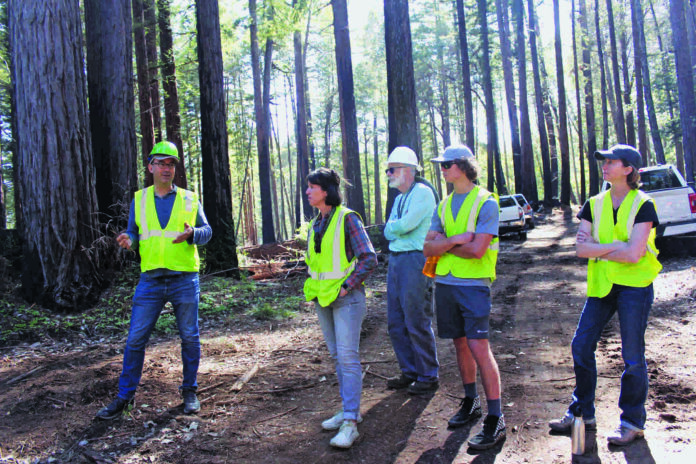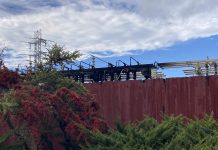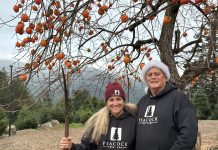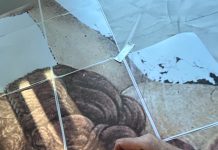
While meeting in the scorching heat at Trinity Bible Church in Felton on a recent Friday afternoon, a group was awaiting a tour of Fall Creek where they’d receive a history lesson about the complex interplay between tan oaks, Douglas fir and coast redwoods over the centuries—and about the technology that could guide their growth in the years to come.
Joe Christy, founder and president of the Bonny Doon Fire Safe Council, was eager to see the results of a fuel break project launched in 2017 and carried out by inmates. Now, a higher-tech version is underway on the landscape, which was scorched by the 2020 CZU Lightning Complex Fire.
“I want to see what it looks like now,” he said.
This was just one of several nature outings organized as part of the California Wildfire and Forest Resilience Task Force’s first Central Coast meeting, to help attendees get a better grasp of the problems they’re trying to tackle.
This particular tour would provide a prime example of the complex interplay that’s sprung up between the worlds of environmentalism, industry, federal oversight, state directives and municipal priorities.
Foresters are being tapped by government to manicure, at-scale, millions of acres of dense, sprawling forest across California to ward off wildfire.
Environmentalists want to preserve the ecology, but some have come to believe that in an era where the CZU Fire—along with the state’s other fires that year—released as many greenhouse gasses as the total emission reductions in California since 2003 (per a UCLA/University of Chicago study in the journal Environmental Pollution), sometimes cutting down a tree can do as much to protect the atmosphere as planting one.
And State Parks is happy to see technological improvements and grants from nonprofits focused in some areas, so it can deploy its troops to other, more critical, pins on the map. For example, Parks wouldn’t have picked the Fall Creek truck trail as its top priority.
But because the Resource Conservation District of Santa Cruz County has been managing the new fuel break project, it’s allowed Parks workers to fan out across the county to carry out other work, including burning about 1,000 piles of brush.
Tim Hyland, senior environmental scientist at California State Parks, says it’s “heartbreaking” when you have to rip out growth to ward off fire, but adds that recent regeneration hints at good things to come for the latest vegetation management push.
“That makes me think that this is going to look even better,” he said, as his pickup wound its way up the mountain.
It turns out it’s cheaper to “treat” a landscape using heavy equipment than it is to pay a crew of laborers.
Because there’s already a road in-place, and the ridgeline provides a slope that machine operators can handle, it makes sense to dispatch heavy equipment here to grind up logs and get rid of unnecessary flammable material, so State Parks can concentrate its efforts elsewhere, says Bradley G. Christiansen, VP of operations for Markit!.
“We’re better off doing areas like this,” he says. “Your dollars go further.”
Angie Richman, the RCD’s forest health program specialist, agrees.
“The price was pretty reasonable,” she says, noting the crews treat about 5-6 acres a day and nesting surveys, paid for by State Parks, are carried out once a week.
Make no mistake, this is precision work.
Unlike the slash-and-burn monoculture approach of years gone by, here arborists assess whether trees should be allowed to continue to lean (for example, if they’re unlikely to fall on the trail), and biologists advise on the perimeter to leave in place around a clump of tall trees to encourage birds to return.
Hyland says they have yet to identify any marbled murrelet by sight or sound. But he’s hopeful that will change soon.
Christiansen says in order to accomplish the dual goals of increased wildfire hardening and more agile understory control, they’ve partnered with Earth Force Technologies.
The San Francisco start-up is supported by around $10 million in seed funding including from Alley Robotics Ventures, Bold Capital Partners and GETTY, a private equity firm.
It’s testing equipment here in the hills above the main San Lorenzo Valley Unified School District tri-campus that looks quite similar to what you might’ve seen on the top of a self-driving vehicle in San Francisco.
Justin Dawe, the company’s CEO, says inventing new tech to help keep people safe from wildfire is personal. After all, his aunt and uncle live down the hill in Ben Lomond. The CZU fire crept within a mile of their home.
And their vice president of operations, Rikard Grunnan—who was also on the tour—owns 20 acres of private forest land nearby. He was at self-driving car company Waymo until last year, but says the 2020 fires were a real wake-up call that inspired him to throw his lot in with Earth Force.
The company’s gear, which includes LIDAR, a GPS tracker and camera equipment, has already come in handy, says Christiansen.
In one case they were alerted to an operator that had accidentally veered into land owned by another forestry company, and were able to correct course before causing too much damage.
Another time, they’d been having trouble wrangling a payment from Cal Fire, who had been questioning if they’d performed the work they were supposed to, until they turned over data collected via the Earth Force platform, he added.
Experts say Silicon Valley has turned its attention to forestry because it’s an industry that hasn’t seen the efficiency gains of other sectors.
Through a fellowship program, Google has even lent out multiple engineers—who attended the task force conference—to help develop a data visualization app meant to be used to streamline planning efforts.
Lisa Lurie, the RCD’s executive director, says the tool could prove useful in helping prioritize various tasks.
“We participated in some early focus groups,” she says, of the software, which is now moving into beta version.
Also represented at the task force gathering was Land Tender, the forest health-focused initial software offering from Vibrant Planet, the Tahoe company backed by former Netflix chief product officer Neil Hunt, Facebook Chief Product Officer Chris Cox and Halogen Ventures.
State Parks officials say efficiency is welcome.
For example, Hyland told the tour group he can get a burn permit for a regular old brush pile “tomorrow,” but as soon as he brings in a fancy aeration burner—which is cleaner and much safer—getting the paperwork sorted out becomes a nightmare.
Christiansen says he understands Hyland’s frustration. He had one of those box burners and couldn’t even find a buyer for it.
In an interview following the previous day’s all-day workshop at the Cocoanut Grove, down at the Santa Cruz Beach Boardwalk, Patrick Wright, director of the governor’s Wildfire Task Force, explains removing red tape is one of the reasons they convened the different players.
“If we’re going to tackle the forest health crisis, it’s gotta be a collaborative effort,” he says. “We’re not going to be able to scale-up unless we work together.”
Task force co-chair Jennifer Eberlien, a regional forester with the National Forest Service, was riding high after a day of presentations and idea-sharing.
But just because she’s optimistic, doesn’t mean the path forward isn’t daunting.
“Our vision is to at least get a million acres treated by 2025 and keep that going,” she says. “You’re prepping that landscape to have fire naturally return.”
The Santa Cruz County get-together was all about solving problems, according to Eberlien.
“We’re here to make lives better,” she said. “We’re here to make the land better.”









